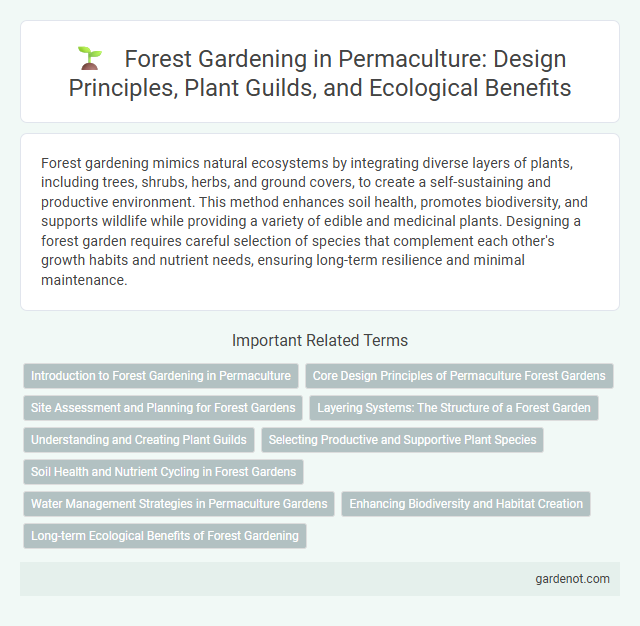Forest gardening mimics natural ecosystems by integrating diverse layers of plants, including trees, shrubs, herbs, and ground covers, to create a self-sustaining and productive environment. This method enhances soil health, promotes biodiversity, and supports wildlife while providing a variety of edible and medicinal plants. Designing a forest garden requires careful selection of species that complement each other's growth habits and nutrient needs, ensuring long-term resilience and minimal maintenance.
Introduction to Forest Gardening in Permaculture
Forest gardening in permaculture integrates diverse layers of edible and useful plants designed to mimic a natural forest ecosystem, enhancing biodiversity and soil health. This sustainable approach emphasizes perennial plants, including trees, shrubs, herbs, and ground cover, creating a resilient food system that requires minimal maintenance. Key benefits include improved carbon sequestration, habitat for wildlife, and efficient nutrient cycling, making forest gardens a vital strategy for regenerative agriculture.
Core Design Principles of Permaculture Forest Gardens
Forest gardening employs core design principles such as diversity, stacking multiple layers of plants to maximize vertical space and resource use, and mimicking natural ecosystems to create self-sustaining, resilient food production systems. Emphasis is placed on the integration of perennial species, nitrogen-fixing plants, and dynamic accumulators to improve soil fertility and structure. Efficient water management and strategic plant placement minimize maintenance while enhancing biodiversity and productivity.
Site Assessment and Planning for Forest Gardens
Effective site assessment for forest gardening involves analyzing soil quality, sunlight exposure, drainage patterns, and microclimates to ensure optimal plant health and productivity. Planning includes selecting appropriate plant species that complement each other and fulfill various ecological roles, such as nitrogen fixation, shade provision, and fruit production. Incorporating natural land contours and existing biodiversity supports sustainable ecosystem functions and maximizes yield over time.
Layering Systems: The Structure of a Forest Garden
Forest gardening employs a complex layering system consisting of seven distinct layers: canopy trees, low trees, shrubs, herbaceous plants, ground covers, root crops, and vertical climbers. These layers mimic natural forest ecosystems to maximize sunlight capture, improve soil health, and increase biodiversity. By integrating diverse plant species with varying heights and root depths, forest gardens create resilient, sustainable food-producing landscapes.
Understanding and Creating Plant Guilds
Forest gardening thrives on the strategic assembly of plant guilds, where complementary species support each other's growth and resilience. Key plant guild components include nitrogen-fixing trees, dynamic accumulators, ground covers, and insectary plants that enhance soil fertility, pest control, and biodiversity. Designing diverse guilds tailored to local climates and soil conditions optimizes resource use and sustains long-term ecosystem health in permaculture systems.
Selecting Productive and Supportive Plant Species
Selecting productive and supportive plant species in forest gardening involves choosing plants that provide food, improve soil health, and create beneficial microclimates. Key species include nitrogen-fixing trees like alder and black locust, fruit-bearing plants such as apple, pear, and hazelnut, and dynamic accumulators like comfrey that enhance nutrient cycling. Integrating ground covers, shrubs, and canopy trees ensures a multi-layered system that maximizes yield and sustainability within the permaculture design.
Soil Health and Nutrient Cycling in Forest Gardens
Forest gardening enhances soil health through diverse root structures that promote aeration and microbial activity essential for nutrient cycling. Decomposing organic matter from multiple plant layers enriches the soil with vital nutrients, supporting sustainable growth without external fertilizers. This natural nutrient recycling system sustains forest garden productivity and resilience by maintaining balanced soil fertility.
Water Management Strategies in Permaculture Gardens
Forest gardening incorporates water management strategies that enhance soil moisture retention and reduce erosion through the use of swales, rain gardens, and mulching techniques. Key elements include contour swales for capturing runoff, perennial plants that improve water infiltration, and layered vegetation that creates microclimates to minimize evaporation. Effective water management in permaculture forest gardens optimizes sustainable water use, supports diverse plant growth, and maintains ecosystem balance.
Enhancing Biodiversity and Habitat Creation
Forest gardening promotes diverse plant layers including canopy trees, shrubs, herbs, and ground covers, which significantly enhance local biodiversity and create stable habitats for wildlife. Integrating nitrogen-fixing species and pollinator-friendly plants supports soil health and attracts beneficial insects, fostering a balanced ecosystem. This self-sustaining agroforestry system mimics natural forests, improving habitat complexity and resilience against environmental stressors.
Long-term Ecological Benefits of Forest Gardening
Forest gardening enhances biodiversity by creating complex multi-layered ecosystems that support a wide range of flora and fauna, promoting natural pest control and nutrient cycling. Its perennial plant systems improve soil structure and carbon sequestration, contributing significantly to climate change mitigation over time. The sustainable design reduces the need for chemical inputs and irrigation, fostering resilient landscapes that adapt to environmental changes and sustain productivity for decades.
Forest gardening Infographic

 gardenot.com
gardenot.com